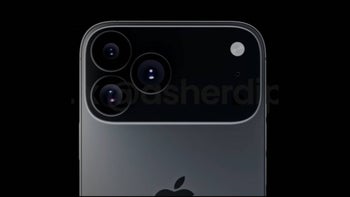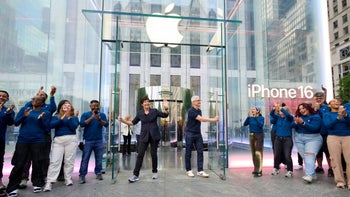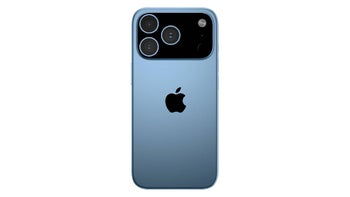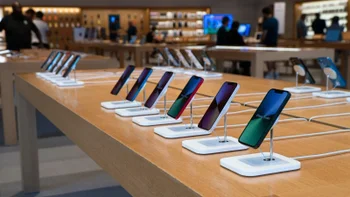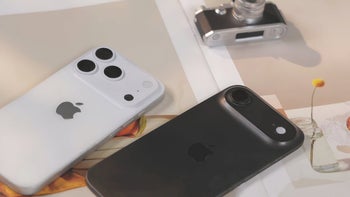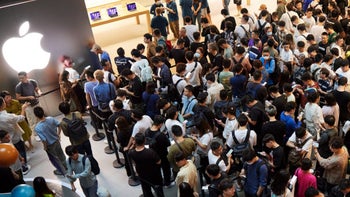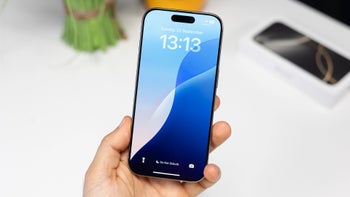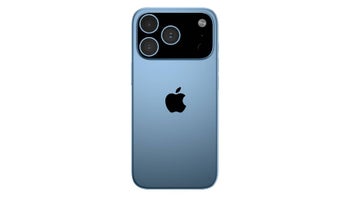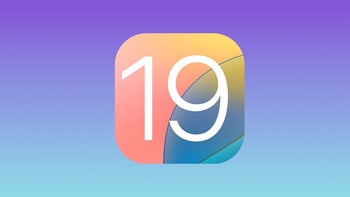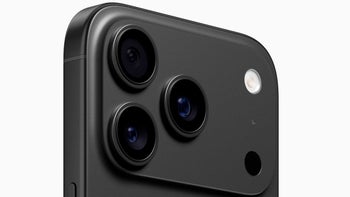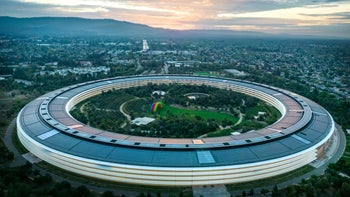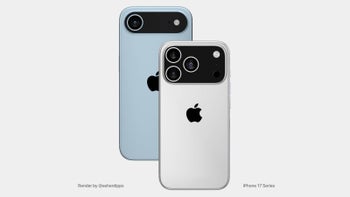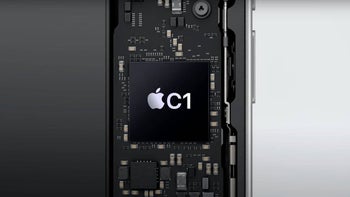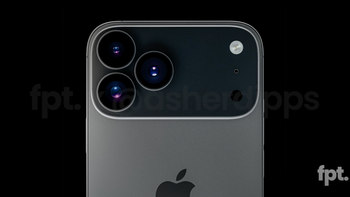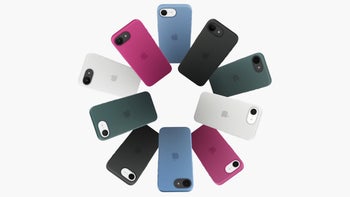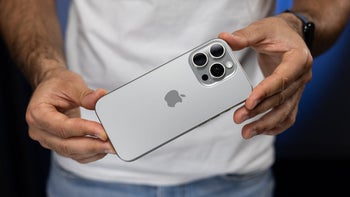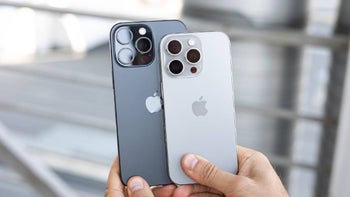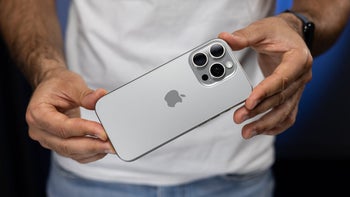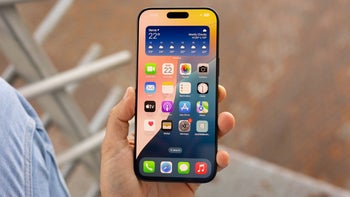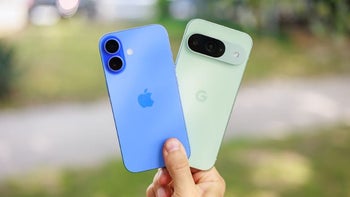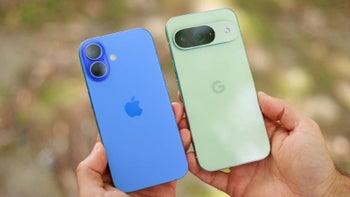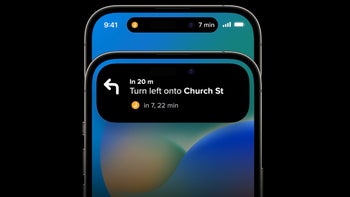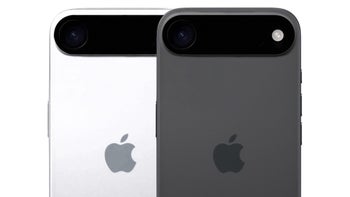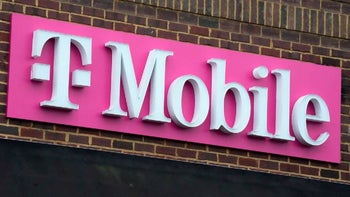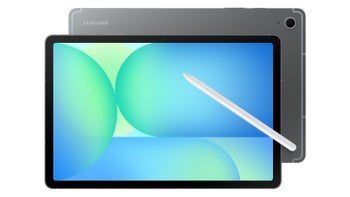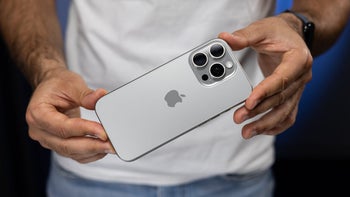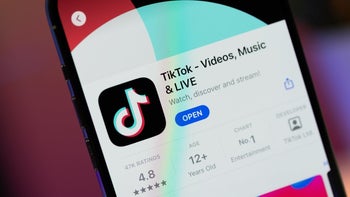iPhone 17 release date expectations, price estimates, and upgrades

What we know so far
The iPhone 17 lineup has the potential to be Apple's most significant release in years, setting the stage for a major shift in design and technology.
John Ternus, the head of the hardware engineering group, describes the iPhone 17 as "the most ambitious in the product's history". The iPhone 17 specs (and the seamless Apple experience) will test tham claim on several months time.
Apple's 2025 phone should arrive with pretty respectable cameras on board (especially for video), with a hardware/software update here and there, but the periscope cameras are reserved for the iPhone 17 Pro and iPhone 17 Pro Max models.
Looking ahead to the Fall of 2025, the iPhone 17 should feature an upgraded front-facing camera with a 24 MP image sensor and six plastic lens elements, an improvement from the 12 MP camera with five elements found on previous generations.
The Apple Intelligence set of features arrived in 2024 (with iOS 18 and the iPhone 16) but these won't be in full motion until 2026, so don't expect the iPhone 17 to be an AI powerhouse right out of the box. Things are to be sorted out and perfected further next year.
Be sure to bookmark this page. We'll update it regularly with credible leaks, rumors and insider information that will roll out gradually in the months to come.
Be sure to bookmark this page. We'll update it regularly with credible leaks, rumors and insider information that will roll out gradually in the months to come.
Let's see what 2025 will bring in terms of iPhone goodness.
Jump to:
iPhone 17 release date
The iPhone 17 should drop in the first half of September, as this is Apple's tradition.
As always, the official unveiling will be followed by a short period of pre-ordering madness; after these (give or take) ten days, the iPhone 17 devices will hit the shelves.
| Device family | Announcement | Market release |
|---|---|---|
| Apple iPhone 17 | 1-15 September* | 10-25 September* |
| Apple iPhone 16 | 9 September, 2024 | 20 September, 2024 |
| Apple iPhone 15 | Sept 12, 2023 | Sept 22, 2023 |
| Apple iPhone 14 | Sept 7, 2022 | Sept 16, 2022 |
* - probable dates
Things are moving according to plan, with Apple increasingly relying on India for iPhone manufacturing, with early production of the base iPhone 17 model now taking place in the country. This marks the first time Apple has used an Indian factory for the initial manufacturing phase, which typically occurs between May and October. Previously, this stage was only conducted in China.
iPhone 17 price
So far, some price hikes are expected to slam the iPhone 17.
| Apple iPhone model | Starting price, regardless of storage |
|---|---|
| iPhone 17 | $799-$899* |
| iPhone 17 Air | $899-$1,299* |
| iPhone 16 (and iPhone 15) | $799 |
| iPhone 16 Plus (and iPhone 15 Plus) | $899 |
* - anticipated prices
iPhone 17 deals to expect:
- Apple: Don't expect the Cupertino giant to suddenly put the kibosh on its iPhone Upgrade program. This is how you can get a new iPhone every 12 months (with AppleCare+ coverage) by simply making 12 payments to Apple and trading in your existing iPhone for the next model. For example, prices historically have started at $39.50/mo for a 128 GB iPhone. You can either sign up online, in the Apple Store app, or in any Apple Store. This is neat.
- Verizon: If nothing changes drastically, the standard iPhone 17 model is anticipated to be potentially available for free with select Unlimited plans and a trade-in of any phone, regardless of its condition, which is a great offer, hands down.
- T-Mobile: Similarly, T-Mobile customers may receive discounts in the $600-$700 range off any iPhone 17 model when choosing the Magenta MAX plan, if that's a thing in 2025. Additionally, given that the telco's strategy doesn't change, a buy-one-get-one (BOGO) deal could allow you to get up to $700 off a second iPhone 17 when adding a line to almost any T-Mobile plan.
- AT&T: AT&T is likely to offer a range of attractive deals for the iPhone 17. Similar to previous offers, the standard iPhone 17 could be free when paired with an eligible AT&T plan and a trade-in of a phone in any condition.
It's important to note that these are just predictions and possibilities, so there's no guarantee that these offers will become reality.
iPhone 17 camera
Even though some Android flagships have outstanding cameras, nobody can deny the fact that iPhones take amazing photos and videos as well.
- What to expect: 48 MP main, 12 MP ultra-wide, 24 MP selfie
You shouldn't be surprised if the iPhone 17 rear camera setup is the one from its predecessor.
Selfie camera upgrade
The iPhone 17's selfie camera will get an upgraded 24 MP sensor, which is great news.
The front camera has remained largely unchanged since the iPhone 11 in 2019, so this upgrade is significant. With a 24 MP resolution, selfies will appear much sharper, and photos will retain better quality even when cropped, offering users more flexibility for post-processing adjustments.
Vertical camera alignment
The front camera has remained largely unchanged since the iPhone 11 in 2019, so this upgrade is significant. With a 24 MP resolution, selfies will appear much sharper, and photos will retain better quality even when cropped, offering users more flexibility for post-processing adjustments.
Vertical camera alignment
Of course, there's no reason to expect that the iPhone 17 will go back to the diagonal alignment of its rear cameras, found on the 14 and 15 series. As you've probably seen already, the iPhone 16 ditched it and replaced it with a vertical layout.
This isn't some sort of paying homage to the iPhone 12 (the last iPhone with a vertical camera alignment): instead, it's because of Apple's Vision Pro headset. Diagonally positioned cameras like the ones on previous iPhone cameras can't record spatial video, while vertical cameras can.
iPhone 17 storage
What to expect:
- 128 GB
- 256 GB
- 512 GB
Keep in mind that the figures above could change in time. Apple might ditch the 128 GB version for the vanilla iPhone 17 and we could jump straight to 256 GB.
Also, there's another reason for the 128 GB starting storage point to be finally got rid of in 2025. It's because of the power- and storage-hungry AI.
Apple may set 8 GB of RAM and 256 GB of storage as the new baseline for all iPhone models, starting with the iPhone 16 series. This increase in storage is because of the expected on-device AI capabilities, which require substantial data, thus boosting storage demands. Similarly, AI processing is driving the need for more RAM, prompting this anticipated upgrade. However, if Apple Intelligence is not ready by September 2025, we could get an iPhone with 128 gigs of storage once again.
The iPhone 15 (and 15 Plus) featured only 6 GB of RAM and 128 GB of storage in their base models.
iPhone 17 design
The end of 2024 brought along some pretty wild design rumors. The iPhone 17 could like something like a Pixel phone, of all things. There was this leaked iPhone 17 frame image that revealed a horizontal Pixel-like camera island.
The start of 2025 brought another portion of design rumors. Apple is reportedly introducing a new splicing process for the iPhone 17, creating a smoother transition between the back and the frame. This technique involves a sloped design where the rear shell meets the main body, replacing the current sharper edges for a more seamless and ergonomic feel. The change, though subtle, could enhance both the phone's aesthetics and its comfort in hand.
Bold design claims
If you're really eager to check out the iPhone 17, you'll be happy to know that there's already this video available:

Of course, this isn't an official clip from Cupertino; it's what the device could look like, as we've reported. Naturally, the video focuses on the Pro Max model, but the standard iPhone model is also right there.
There are also metal molds of the iPhone 17 lineup that – if credible – hint at the vanilla flagship's exteriors:
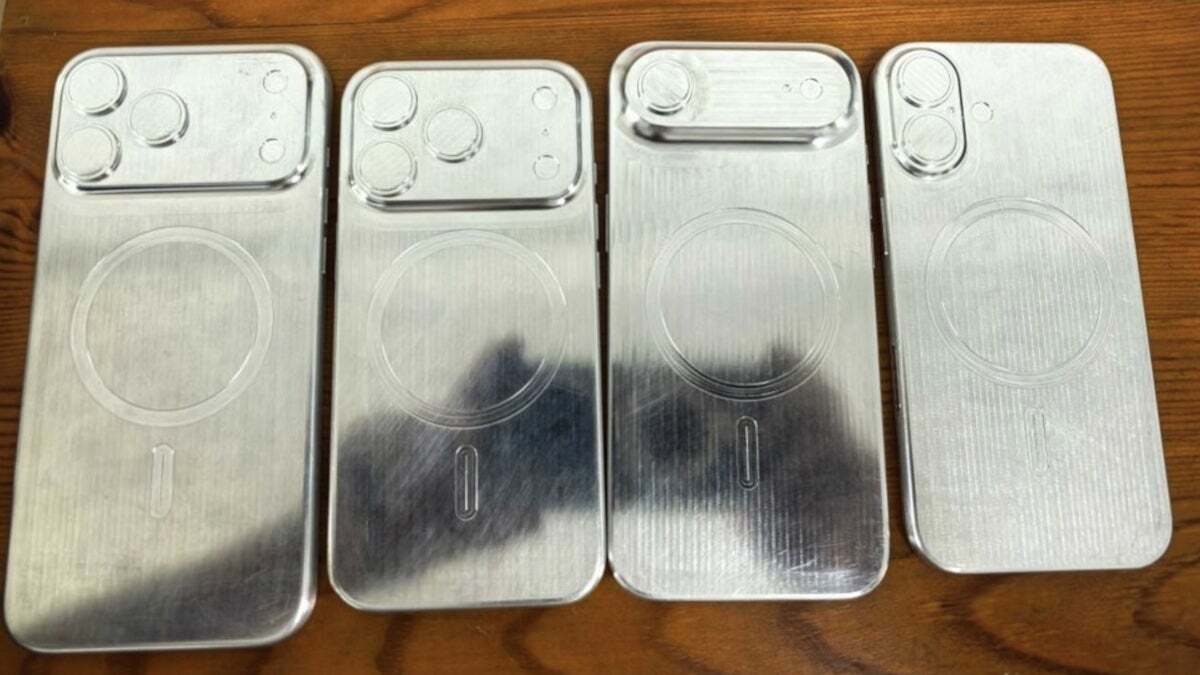
Metal molds of the iPhone 17 line. | Image credit – Sonny Dickson via AppleInsider
As you can see, the iPhone 17 is not that different from the iPhone 16.
Camera Control button
The Camera Control button that debuted on the iPhone 16 series should be once again present on the iPhone 17.
It does more than just the usual "click". Just as rumors foretold, it offers zoom and focus controls as well. Sources were right to tell this button is not just a standard mechanical one; it’s touch-sensitive as well. Users can swipe to adjust zoom levels, with a half-press focusing the shot.
While a light press handles focusing and brings up several dedicated-camera-like functionalities, a firm press captures the image or starts recording.
However, the iPhone 17 might have less buttons overall, compared to its predecessor.
While a light press handles focusing and brings up several dedicated-camera-like functionalities, a firm press captures the image or starts recording.
Or less buttons?
However, the iPhone 17 might have less buttons overall, compared to its predecessor.
As you know, Apple introduced the Action Button in 2023, replacing the traditional mute switch. The iPhone 16 includes the additional "Camera Control" button that we talked about above, which allows users to take photos and zoom by sliding along the button. This brings the iPhone 16 to five physical buttons.
However, Apple is reportedly planning a change for the iPhone 17, combining the Action Button and volume controls on one side, while keeping the Camera Control on the other. This move would reduce the number of buttons to three. The merged button may function as both an Action Button and volume control, with sliding actions adjusting volume and pressing it possibly launching apps or muting the phone.
Bezels to get thinner
The iPhone 17 is to inherit the super-thin bezels that debuted on the 2024 iPhones.
That's thanks to the so-called BRS (Border Reduction Structure) technology to minimize the display bezels. The iPhone 16 Pro Max arrives with ultra-thin 1.15mm bezels: now that's impressive!
Reducing the size of the top and side bezels is more or less easily achievable, but the bottom bezel surely got some Apple engineers to scratch their heads longer than what's generally accepted. That's because the bottom bezel poses a challenge due to heat generation issues. The new BRS technology seems to address this by allowing the bottom bezel to be as thin as possible. It achieves this by rolling the copper wires at the bottom upward.
If we use the current iPhone 16 hue palette, this means that the 17 might come in:
That's thanks to the so-called BRS (Border Reduction Structure) technology to minimize the display bezels. The iPhone 16 Pro Max arrives with ultra-thin 1.15mm bezels: now that's impressive!
Reducing the size of the top and side bezels is more or less easily achievable, but the bottom bezel surely got some Apple engineers to scratch their heads longer than what's generally accepted. That's because the bottom bezel poses a challenge due to heat generation issues. The new BRS technology seems to address this by allowing the bottom bezel to be as thin as possible. It achieves this by rolling the copper wires at the bottom upward.
Colors to pick from
If we use the current iPhone 16 hue palette, this means that the 17 might come in:
- Black
- White
- Pink
- Teal
- Ultramarine
iPhone 17 display
New panels and new size
Recent leaks from tipster claim all iPhone 17 models – yes, even the "vanilla" flagship – will feature Samsung's M14 OLED panels, a significant upgrade from previous models. The M14 panel, used in the iPhone 16 Pro, offers 30% higher brightness, better lifespan, and lower power consumption compared to the M13.
Non-Pro iPhone 16 models used the older M12 panel, similar to the iPhone 15. Anyway, the iPhone 17 series will still benefit from improved brightness and battery efficiency.
We'll also most likely see improved durability, because Apple introduced a 2nd-gen Ceramic Shield for the iPhone 17's predecessor.
Apart from that, the vanilla iPhone 17 will probably grow slightly in size with its rumored 6.27-inch display. On the 16 series, it was a 6.12-inch one (as on the iPhone 15).
The LTPO display claims
Previous rumors claimed that Apple is reportedly planning to equip all four iPhone 17 models with low-temperature polycrystalline oxide (LTPO) displays, including the standard iPhone 17 and iPhone 17 Slim, along with the Pro models.
LTPO technology allows for variable refresh rates, enhancing power efficiency, and is the foundation for features like the always-on display in the iPhone 16 Pro. BOE, despite advancements in OLED technology, has lost out on supplying LTPO display due to reliability issues. LG Display and Samsung will handle the bulk of the iPhone 17's display orders. BOE's past struggles with Apple, including design alterations and failure to meet specifications, have prevented it from securing iPhone contracts.
Higher refresh rate?
ProMotion, previously exclusive to the Pro models, may now be extended across the entire iPhone 17 lineup. Rumors first surfaced earlier this year, with reliable tipster Ross Young predicting that all models in the iPhone 17 would get a 120Hz refresh rate. Subsequent reports have supported this, suggesting both ProMotion and Always-On displays will be available across all models.
iPhone 17 battery
These are still just rumors and nothing is confirmed.
Significant battery capacity increases for the iPhone 17 lineup seem unlikely, with only minor improvements expected.
While the iPhone 17 may feature around a 3,600 mAh battery, those looking for larger capacities might need to explore other brands like OnePlus.
New adhesive
Currently, there are rumors that Apple’s new battery adhesive, introduced with the 2024 iPhones, will be implemented across all four iPhone 17 models next year. This innovative adhesive allows Apple to use electrically induced adhesive peel technology, enabling the battery to be easily removed by applying a small electric current. The current weakens the adhesive's bond, allowing the battery to detach with minimal effort.
Once removed, a new layer of adhesive will be applied to secure the replacement battery. This technology eliminates the need for heat guns, crowbars, or force when replacing an iPhone battery. By testing this adhesive on the current non-Pro iPhone models, Apple can gather feedback from Genius Bar technicians, helping ensure smooth implementation across the iPhone 17 lineup.
Once removed, a new layer of adhesive will be applied to secure the replacement battery. This technology eliminates the need for heat guns, crowbars, or force when replacing an iPhone battery. By testing this adhesive on the current non-Pro iPhone models, Apple can gather feedback from Genius Bar technicians, helping ensure smooth implementation across the iPhone 17 lineup.
Stacked battery tech?
It could be the case that the iPhone 17 will benefit from the stacked battery tech that first showed up in 2023. This is the reason iPhone 15 owners could enjoy better battery life than the iPhone 14 crowd.
In 2023, Apple surprised everyone by revealing the iPhone 15's battery performance was better than predicted. Initially, they said it would keep 80% of its original capacity after 500 charge cycles, but later improved that estimate across the entire iPhone family. Sure, it doesn’t match the blazing 210W charging speeds seen in Chinese phones like Vivo or Xiaomi, but it’s got some tricks worth mentioning.
Since 2023, the battery utilizes a "stacked" method, borrowing from the way electric vehicle batteries are made. It's more uniform and stable compared to the older "winding" method, which takes up more space. Though winding batteries are cheaper and more durable, stacked batteries provide better energy density and stability, which helps in delivering longer battery life.
In 2023, Apple surprised everyone by revealing the iPhone 15's battery performance was better than predicted. Initially, they said it would keep 80% of its original capacity after 500 charge cycles, but later improved that estimate across the entire iPhone family. Sure, it doesn’t match the blazing 210W charging speeds seen in Chinese phones like Vivo or Xiaomi, but it’s got some tricks worth mentioning.
iPhone 17 features and software
- It will run on iOS 19
- Apple Intelligence might not be fully ready for the iPhone 17
It was widely expected that 2025 would be the year Apple fully caught up with other brands in AI. However, whether that will actually happen remains uncertain.
Apple fans and insiders have been repeating for over a year now that Apple is "way behind" the competition in the AI race.
During the June 2024 WWDC, Apple did present iOS 18 and promised to heavily emphasize AI for the iPhone. In what's best described as a typical Apple move, the Cupertino giant announced its Apple Intelligence (yeah, that's the humble term they're using for their upcoming set of artificial intelligence features) to be available for only a handful of iPhones back then.
These were:
However, things took a turn for the worse in early 2025.
During the June 2024 WWDC, Apple did present iOS 18 and promised to heavily emphasize AI for the iPhone. In what's best described as a typical Apple move, the Cupertino giant announced its Apple Intelligence (yeah, that's the humble term they're using for their upcoming set of artificial intelligence features) to be available for only a handful of iPhones back then.
These were:
- iPhone 15 Pro
- iPhone 15 Pro Max
- iPhone 16 series
However, things took a turn for the worse in early 2025.
Apple's AI tools, initially promised for release, are now delayed indefinitely due to readiness issues, and the company has taken full accountability for the marketing of incomplete features. While no immediate layoffs are planned, adjustments within the company are underway, including shifts in leadership, to fix the Apple Intelligence issues. Apple has clarified that the AI tools will now be released in a future update, with plans to only launch when the product is perfected.
The AI revamped Siri, for example, is going to be really late. Robby Walker, who leads Siri's team, has called the delays "embarrassing" and "disappointing". This situation is reminiscent of when Tim Cook publicly apologized for the Apple Maps disaster in 2012.
iOS 19: what to expect?
With iOS 18, we're got some new features that include free-form app icon placement, deep app icon customization (allowing for resizing icons and adding a colorful tint), customizable lock screen shortcuts, and a redesigned Control Center.
With iOS 19, these areas could receive a further boost and users could get even more control over the way the iPhone looks.
With iOS 19, these areas could receive a further boost and users could get even more control over the way the iPhone looks.
iPhone 17 hardware
What to expect:
- CPU: Apple A19 chip
- RAM: 8 GB
- Battery: ~3,600mAh
- Storage: 128 GB, 256 GB, 512 GB
- Camera setup: 48 MP main, 12 MP ultra-wide, 24 MP selfie
Chipsets, also known as SoCs, are crucial – they're essentially the heart (and brain) of your phone.
A System-on-Chip (SoC) integrates most or all components of a computer or electronic system onto a single chip. It typically includes a central processing unit (CPU), memory interfaces (for RAM and ROM), input/output interfaces, and often additional features like a graphics processing unit (GPU), communications modules (e.g., Wi-Fi, Bluetooth), and more.
So, given that Apple's A18 chip lands on the iPhone 16 series (the 16 Pro and 16 Pro Max received the boosted A18 Pro model), we could get A19 and A19 Pro on the iPhone 17 and iPhone 17 Pro.
What is the A19 going to be like? Will it be a 3nm SoC – like the A17 Pro and the A18/18 Pro – or will it be a 2nm SoC?
In the realm of System-on-Chip (SoC) technology for mobile phones, "nm" (nanometer) denotes the size of components like transistors on the chip. A nanometer is one billionth of a meter, underscoring the minuscule scale of these elements. Smaller nanometer technology enables more chips by allowing more transistors to fit into a compact space. Basically, the smaller the "nm" number of a SoC, the more power efficient and powerful your phone gets.
However, in mid-April 2024, there came a cold shower of rumors that claimed Apple won't make it to the 2nm level for the iPhone 17 and the A19 chip. In September 2024, the same thing was stated again:
Meanwhile, Samsung is trying to beat Apple at their own game. For the Galaxy S26 Ultra, the Korean giant is dreaming of packing a 2nm Exynos 2600 chipset.
If Apple doesn't manage to come up with a 2nm chip for the iPhone 17 lineup, this will mean that Samsung and its Galaxy S26 Ultra (expected in the very beginning of 2026) will be the first phone with a 2nm chip inside.
The iPhone 17 will feature custom-designed Wi-Fi and Bluetooth chips, supporting the Wi-Fi 7 standard to improve performance, energy efficiency, and integration within Apple's ecosystem. This move reduces reliance on third-party suppliers like Broadcom. Additionally, Apple's development of its own 5G modem, "Centauri", promises enhanced connectivity, security, and cost-efficiency, making the iPhone 17 a more powerful and seamless device.
Should I wait for the iPhone 17?
- You should wait for the iPhone 17 if you're deep in the Apple ecosystem and you can't stand the idea of using a phone for more than a year. If you're after a phone with a 2nm chip – if Apple manages to get it ready for 2025, though – 17 is your lucky number. If you want to see Apple Intelligence in full swing – you guessed it – the iPhone 17 is the one for you. If you're using iPhone 14 or older, I think the 17 might be the correct model for you.
- You should not wait for the iPhone 17 if you're a die-hard Android fan (that was obvious). If you have the iPhone 15 Pro, for example, it would be probably best not to switch to the vanilla iPhone 17, but check out its bigger siblings.

